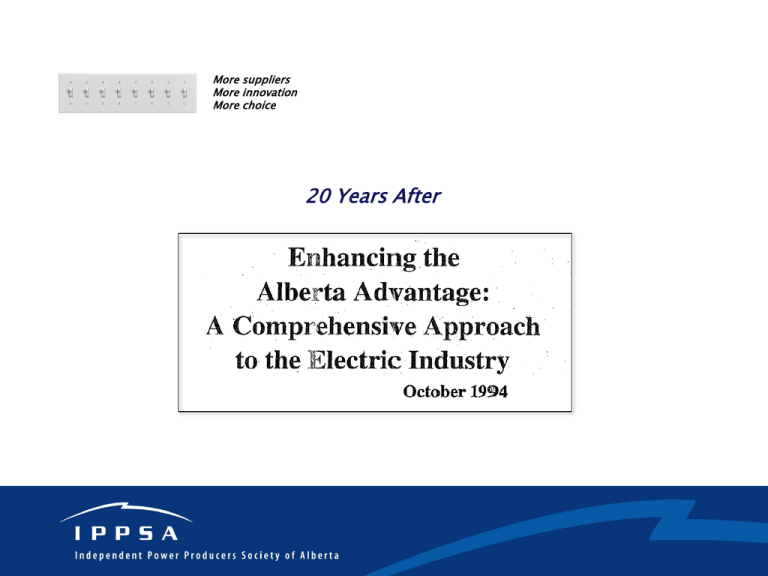20 years after white paper
advertisement

More suppliers More innovation More choice 20 Years After Overview • Twenty years ago Enhancing the Alberta Advantage was issued. • This was the Department of Energy’s white paper that kicked off our market’s restructuring. The paper states, • The following takes a number of forecasts and data points of Alberta’s power industry from 1994 and compares them to how our market’s history has actually evolved. .. 1) The Supply and Demand Forecast • Page 13 of the 1994 white paper provided this snapshot of Alberta’s supply/demand forecast: • In 1994, Alberta had 7000 MW of supply and was expected to hit 10,000 MW of demand in 2022 1) The Supply and Demand Forecast • In reality, demand hit 9900 MW in winter of 2009, or 13 years ahead of the forecast. • Today, Alberta has 15,877 MW of supply, or more than twice what we had in 1995. • We’ve added 9000 MW - or 2.5 ‘SaskPowers’ - in 20 years. • Demand growth has averaged almost twice the 1.8% estimated in 1994. 2) Competition has Shifted Investment Risk to Developers • In Alberta’s open market, developers take investment risk. This drives efficiency. This efficiency is reflected in lower offers in the energy market and a downward pressure on prices. It also leads to the retirement of inefficient supply. • As a result of this shift of investment risk, Alberta has been a rapid adopter of efficient generation as evidenced by our cogen volumes, large-scale wind turbines, and supercritical coal plants. • Furthermore, developers no longer have recourse to consumers to backstop their investments, which is function of regulated regimes… Ontario electricity consumers on the hook for power plant construction The Globe and Mail, Monday 24th September, 2012 BC Hydro ratepayers on hook for $750 million Powerex settlement - Commonsense Canadian, 17 August 2013 3) Introducing Competition and New Generation Entrants Comparing the generation market of 1994 to 2014 demonstrates the significant decontrol of generation that has occurred and the introduction of new entrants. Source: MSA 4) Wholesale Price Outcomes • The 1994 White Paper included a forecast of generation cost. • Since the market opened in 2001, wholesale prices have averaged $66/MWh. • This is not far off the forecast, which is remarkable considering that demand growth doubled from the 1994 projections. And gas prices, a key power price driver, have undergone dramatic increases since the $1.92/GJ of1994. (Fekete Associates) $66/MWh average Alberta wholesale Market price (2001-2013) 4) Wholesale Price Outcomes • Today, Alberta’s market is extremely competitive • 2014 pricing is below the levelized cost of all new power supply, except cogen. Costs) Compliance Costs (exlcuding GHG Unit Comparative Levelized Levelized Costs (2013-2027, using EDCA Q1, 2013 Report Assumptions) EDCA - Q3-2011 Quarterly Forecast Update $180 Capital Structure of 60/40 with D&E costs of 7% and 15%, respectively. Construction start date of 2011. Average natrual gas price pf $4.57/GJ (2011$). $160 Capital Fuel Var O&M Fx O&M G&A Property Tax Transmission Tariffs $140 $/MWh (2011$) $120 $100 $80 $55/MWh YTD prices $60 $40 $20 $0 Cogeneration CCGT CT Simple Cycle Combined Cycle with Surplus Power Subcritical Coal Brownfield Supercritical Coal Mid Sized Hydroelectric Large Scale Wind Power Advanced Nuclear 45% CF 75% CF 85% CF 90% CF 90% CF 67% CF 35% CF 90% CF 30-Year Life 30-Year Life 30-Year Life 40-Year Life 40-Year Life 40-Year Life 20-Year Life 40-Year Life Source: EDC Associates 5) Alberta’s Residential Compared to Other Provinces • Page 5 of the White Paper shows that Alberta’s and Canada’s residential rates were ~ ¢10/Kwh. • Twenty years later, Alberta remains in close proximity to the national average, even as supply has more than doubled, and gas prices have risen dramatically. 2013 Residential Electricity Rates by Province Host of Industry Issues Source: London Economics Int, 2014 6) Providing Choice to Consumers in Managing Price • Page 3 of the White Paper promoted customer choice as a policy goal. • Today, Alberta consumers can choose fixed-priced contracts, flow-through contracts, dual fuel contracts (gas & power), green power or on-site generation. (Recently, ENMAX added its100th residential solar system) • The following shows the percentage of Albertans who have exercised choice: Source: UCA 7) Greening Alberta’s Grid • An outcome not forecast in 1994 was the market’s continued emissions improvements. • From Trends in GHG Emissions in the Alberta Electricity Market, 2013, EDC Associates forecasts that Alberta’s electricity emissions intensity to halve by 2050, due to the market’s migration to baseload natural gas supply . Emission Intensities (t/MWh) by Fuel Type Contribution to Emission Intensity (t/MWh) Across the Study Period (2013-2050) 0.70 0.50 0.40 0.30 0.20 0.10 Coal Cogen Combined Cycle Simple Cycle Hydro Tie Wind Other 20 49 20 47 20 45 20 43 20 41 20 39 20 37 20 35 20 33 20 31 20 29 20 27 20 25 20 23 20 21 20 19 20 17 20 15 0.00 20 13 Emission Intensities (t/MWh) 0.60 7) Greening Alberta’s Grid • Tonnage of CO2 emitted is set to fall from 2013 to 2030. • Tonnage is forecast to rise from 2030 to 2050 by 7%, even as fleet increases by 100%. Should gas turbine technology continue to improve, or Alberta’s demand slow, tonnage of power sector emissions could even fall by 2050 from 2013 levels. Total Emissions (t) (2013-2050) Emissions Pattern (Mt) Delayed 30 Years 70 60 Mt 50 40 30 20 10 0 $0/t $15/t $30/t $60/t •Source: EDC Associates Ltd. Conclusion • Who could have imagined how Alberta’s power market would evolve in the 20 years since Enhancing the Alberta Advantage was first issued? • Yes, the authors missed ENRON, and gas prices rising from $2 to $12 and plummeting back to $2 and everything in between, and Alberta’s protracted, unparalleled economic boom, and landowner transmission backlash, and Bill 50, and climate change policy… But some of the document’s original goals of introducing competition and choice have been achieved. • Evaluating the merits of the market’s 20-year evolution from the white paper should be based on the facts of what the market has produced. IPPSA hopes the preceding has provided some context for that review.











